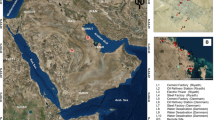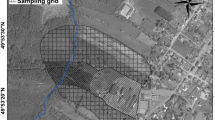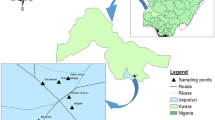Abstract
Background, Aims and Scope
The Rocky Mountain Arsenal (RMA) is a US Army facility located northeast of Denver, Colorado that has been listed on the National Priorities List (NPL). It is currently being re-mediated under the authority of the Comprehensive Environmental Response, Compensation, and Liability Act of 1980 (CERCLA) and the Superfund Amendments and Reauthorization Act of 1986 (SARA). As part of the remediation activities at RMA, indications were found that a source of polychlorinated dibenzo-p-dioxins (PCDDs) and polychlorinated dibenzofurans (PCDFs) had existed on the RMA. As a result, investigations were undertaken to assess the possible nature and extent of any potential sources of PCDDs and PCDFs on the RMA site. In addition, other studies were conducted that examined PCDD/PCDF contamination in the Denver area. The goal of these studies was to examine nature and extent of PCDD/PCDF contamination both on the RMA as well as in the surrounding Denver area. The intent of this study was to characterize sources of dioxins (PCDDs) and dibenzofurans (PCDFs) at low environmental concentrations which might have originated from diffuse sources in the Denver Colorado area and in particular, the Rocky Mountain Arsenal (RMA) using Principal Component Analysis (PCA).
Methods
Over 200 soil samples were collected from the RMA and the Denver area. From the RMA, soil was collected as part of three studies that included a (1) random site-wide sampling of the RMA, (2) soils from the Western Tier Parcel (WTP), and (3) soils from Historic Use areas. Denver area soil samples were collected from five different land use categories: Residential, Agricultural, Open Space, Commercial, and Industrial. PCA was conducted on concentrations of 17 2,3,7,8-substuituted PCDD and PCDF congeners in 220 soil samples collected from the RMA and the Denver Front Range region.
Results and Discussion
PCA demonstrated the presence of possible minor sources of dioxins on the RMA. Current remediation efforts on RMA will result in the removal of these sources. Samples from the RMA were identified by the presence of a congener profile containing higher chlorinated PCDFs while the Denver Front Range areas were characterized by the presence of higher chlorinated PCDD congeners. The presence of a PCDF signature for the RMA samples does not necessarily indicate a major source of these contaminants on-site. Indeed, the relatively diffuse nature of the sample clusters would argue strongly against the presence of a single large source. Instead, the predominance of the PCDF congeners probably indicates the mixed industrial activities that took place on and near the site.
Conclusion
PCA results indicate that PCDD/PCDF profiles in soils collected from the RMA differed from those collected from the outlying Denver areas but that a major source of these contaminants was not present. Rather, the diffuse nature of sample clusters from the PCA indicated that the congener profile of RMA samples was most likely a result of the mixed industrial activities that historically have taken place on and near the site. PCA also indicated that many of the 'open area' (peripheral site-wide) RMA soils samples did not differ from Denver are reference congener profiles. This finding was also true for samples collected from the WTP that were essentially indistinguishable from Off-RMA reference samples. In addition, total TEQ concentrations in soils collected from WTP were similar to those measured in soils collected from the Denver Front Range areas indicating that lack of a major source of PCDD/PCDF within the WTP zones of the RMA.
Recommendation and Outlook
Analytical as well as statistical results of the soil congener data indicate that the WTP soils are indistinguishable from soils collected from non-industrial areas in the Denver area. This finding would support the recent 'de-listing' of the WTP from the other RMA areas and its' transfer to other authorities in the Denver area.
Similar content being viewed by others
Author information
Authors and Affiliations
Corresponding authors
Rights and permissions
About this article
Cite this article
Jones, P., Newsted, J., Henningsen, G. et al. Distribution of PCDDs and PCDFs in Soils Collected from the Denver Front Range - Principal Components Analysis of Diffuse Dioxin Sources (10 pp). Env Sci Poll Res Int 12, 189–198 (2005). https://doi.org/10.1065/espr2005.06.271
Received:
Accepted:
Published:
Issue Date:
DOI: https://doi.org/10.1065/espr2005.06.271




